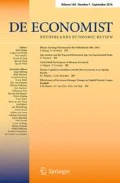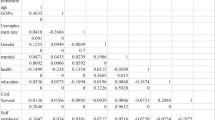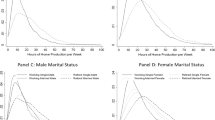Abstract
We measure the economic contribution of older adults (i.e., adults age 60+) in Europe and the US by examining participation in and calculating value generated by market activities and productive non-market activities (PNMA). We find that the estimated value of market and non-market contributions of older adults in the sample countries in Europe and the US sum to the equivalent of 7.3% of gross domestic product, while older adults make up 24% and 21% of the European and US population, respectively. In addition, notable variation exists in the composition of older adults’ economic contributions by age group, national setting, and gender—with a significant proportion of overall value generated from PNMA when monetized in relation to market activities. Regarding retirement policy, we find at the country level that the value generated from increased employment may be offset by the loss of value from decreased PNMA and that the impact of retirement policy on overall productivity depends on the ratio of market to non-market productivity in a country. Finally, we find that severe but common health shocks such as heart attacks, strokes, and the onset of cancer affect both market activities and PNMA appreciably across countries and genders, with an overall greater reduction in market activities by males and in PNMA by females. Taken together, we show that PNMA comprises a substantial share of older adults’ productive contributions and argue that it should be considered in policy discussions regarding retirement age, pension taxes, and healthy aging.










Similar content being viewed by others
Notes
Throughout the paper, references to “working” or “employed” individuals include those who performed paid work within the last week, even if they described themselves as retired, disabled, or unemployed. This matches the definition of participating in the labor force used in Achdut et al. (2015) and Trevisan and Zantomio (2016).
Several categories of PNMA are not included in these analyses (e.g., household labor). Thus, the estimates of PNMA value presented in this paper should not be considered exhaustive, but rather represent a lower bound of the value created given the available data.
National average values are used for these adjustments because the surveys do not contain sufficient information to estimate the worker-specific values of taxes paid accurately. However, because the occupational distribution of older workers does not match that of the rest of the population, the percentage of earnings paid in taxes for older workers may differ from the population average. As such, using population average values to adjust the earnings of older adults introduces a bias of ambiguous effect. The HRS provides pre-tax earnings so these values are not adjusted.
These wages are also adjusted upward to reflect their total pre-tax value.
The International Standard Classification of Occupations (ISCO-08) codes for childcare workers and home-based personal care workers are 5311 and 5322, respectively. These workers earn roughly €12 per hour in the US sample, and approximately €15 per hour in the European sample.
Elementary occupations are as defined according to the International Standard Classification of Occupations (ISCO) code reported in the survey. Examples of work covered by this category include agricultural labor, manufacturing, and cleaning services.
We use the term “market skilled” to refer to labor that is as productive as the individuals’ estimated hourly productivity through employment.
Value of PNMA is moderately sensitive to this methodological choice. In Europe, the value of PNMA contributions increases by 10% if volunteering is valued at market skilled wages and decreases by 10% if it is valued at unskilled wages. In the US, these values increase or decrease by 20%, respectively.
HRS reports hours spent volunteering, helping others outside the household, and taking care of grandchildren over the last week. The assumption is that time spent on an activity over the last week is representative of the average amount of time spent on that activity per week over the last year.
The population weights used are those provided in the SHARE, ELSA, and HRS datasets.
Some individuals who participated in employment or PNMA are missing observations for variables included in the regression model. As such, the model cannot predict the value of these individuals’ contributions. Thus, the model slightly underestimates the total contributions of older adults represented by the sample in 2015, producing a slight “year-one estimation bias”.
For a comprehensive description of the theoretical underpinnings, technical specifications, and implementation of the model, readers are referred to Trevisan and Zantomio (2016). We do not specify caliper width, and by default all observations are potential matches; we use one-to-one nearest neighbor matching with replacement.
The validity of this approach relies on the conditional independence assumption (CIA) that matching on the basis of the observed confounders is sufficient to ensure that the occurrence or non-occurrence of AHS can be considered essentially random. As the CIA is untestable, its validity relies on the comprehensiveness of the set of observed confounders. Given the wide range of data utilized in the matching process, which cover underlying health trajectories, genetic predispositions, health-related behavior, and other risk factors, we consider the CIA to be plausible in this case.
For more details on the model specification used please refer to Trevisan and Zantomio (2016).
GDP figures do not include any approximation of non-market activity and all references to GDP and GDP per capita in this paragraph are made only as a point of comparison for the magnitude of these contributions.
Aggregate contributions of older adults are smaller as a share of total GDP because these adults make up only 21% of the total population in the US and 24% of the European countries studied.
See 3.2 for a description of the methodology used for our sensitivity analysis.
In the baseline scenario official retirement age is held constant at its 2015 value for each country in the sample.
Thirty-two percent of participants in the SHARE sample were employed at the time of the first health shock, and relative percentage change is calculated using this ratio. Thirty-seven percent of participants in the ELSA sample and 38% in the HRS sample were employed at the time of the first health shock.
The impact of the health shock on likelihood of employment is displayed in absolute, percentage point terms in the tables.
Initial PNMA participation rates at the time of the health shock were 45% for the SHARE sample, 41% for the ELSA sample, and 62% for the HRS sample.
References
Abadie, A., Drukker, D., Herr, J. L., & Imbens, G. W. (2004). Implementing matching estimators for average treatment effects in Stata. The Stata Journal,4(3), 290–311.
Abeliansky, A., Algur, E., Bloom, D.E., & Prettner, K. (2019). The future of work: Challenges for job creation due to global demographic change and automation (Manuscript in preparation).
Achdut, L., Tur-Sinai, A., & Troitsky, R. (2015). Transitions between states of labor-force participation among older Israelis. European Journal of Ageing,12(1), 39–49.
Beaudry, P., Green, D. A., & Sand, B. M. (2016). The great reversal in the demand for skill and cognitive tasks. Journal of Labor Economics,34(S1), S199–S247.
Bloom, D. E., Canning, D., & Fink, G. (2010). Implications of population ageing for economic growth. Oxford Review of Economic Policy,26(4), 583–612.
Bloom, D. E., Canning, D., & Lubet, A. (2015). Global population aging: Facts, challenges, solutions and perspectives. Daedalus,144(2), 80–92.
Bloom, D. E., & Finlay, J. E. (2009). Demographic change and economic growth in Asia. Asian Economic Policy Review,4(1), 45–64.
Börsch-Supan, A. (2018). Survey of health, ageing and retirement in Europe (SHARE) waves 1–6. Release version: 6.1.0. SHARE-ERIC. Data set. https://doi.org/10.6103/share.w6.610.
Bridgman, B., Dugan, A., Lal, M., Osborne, M., & Villones, S. (2012). Accounting for household production in the national accounts, 1965–2010. Survey of Current Business,92(5), 23–36.
Chiappori, P. A. (1997). Introducing household production in collective models of labor supply. Journal of Political Economy,105(1), 191–209.
Coile, C. (2004). Health shocks and couples’ labour supply decisions. NBER Working Paper No. 10810, Cambridge, MA.
Friedberg, L. (2000). The labor supply effects of the social security earnings test. Review of Economics and Statistics,82(1), 48–63.
Futagami, K., & Nakajima, T. (2002). Population aging and economic growth. Journal of Macroeconomics,23(1), 31–44.
Griffin, B., & Hesketh, B. (2008). Post-retirement work: The individual determinants of paid and volunteer work. Journal of Occupational and Organizational Psychology,81(1), 101–121.
Hammer, B., Spitzer, S., Vargha, L., & Istenič, T. (2020). The gender dimension of intergenerational transfers in Europe. The Journal of the Economics of Ageing,15, 100234.
HRS (Health and Retirement Study). (2018). Public use dataset. Produced and distributed by the University of Michigan with funding from the National Institute on Aging (grant number NIA U01AG009740), Ann Arbor, MI.
Hurd, M. D., & Rohwedder, S. (2007). Time-use in the older population: Variation by socio-economic status and health. RAND Corporation, Santa Monica, CA. https://www.rand.org/pubs/working_papers/WR463.html.
ILO (International Labour Organization). (2018). Survey methods to improve measurement of paid and unpaid work: Country practices in time-use measurement. In 20th international conference of labor statisticians, Geneva, pp. 14, 24–26.
Kalache, A., Aboderin, I., & Hoskins, I. (2002). Compression of morbidity and active ageing: Key priorities for public health policy in the 21st century. Bulletin of the World Health Organization,80, 243–244.
Kydland, F., & Pretnar, N. (2019a). Who will care for all the old people? In D. Bloom (Ed.), Live long and prosper? The economics of ageing populations (pp. 18–23). London: VoxEU.
Kydland, F., & Pretnar, N. (2019b). The costs and benefits of caring: Aggregate burdens of an aging population (No. w25498). Cambridge, MA: National Bureau of Economic Research.
Landefeld, J. S., Fraumeni, B. M., & Vojtech, C. M. (2009). Accounting for household production: A prototype satellite account using the American Time Use Survey. Review of Income and Wealth,55(2), 205–225.
Lee, R. D. (2016). Macroeconomics, aging, and growth. In J. Piggott & A. Woodland (Eds.), Handbook of the economics of population aging (Vol. 1A, pp. 59–113). Amsterdam: North-Holland.
Lee, R. D., & Mason, A. (Eds.). (2011). Population aging and the generational economy: A global perspective. Cheltenham: Edward Elgar Publishing.
Maassen van den Brink, H., & Groot, W. (1997). A household production model of paid labor, household work and child care. De Economist,145, 325–343.
McDaid, D. (2001). Estimating the costs of informal care for people with Alzheimer’s disease: Methodological and practical challenges. International Journal of Geriatric Psychiatry,16(4), 400–405.
Moro, A., Moslehi, S., & Tanaka, S. (2017). Does home production drive structural transformation? American Economic Journal Macroeconomics,9(3), 116–146.
Muschik, D., Icks, A., Tetzlaff, J., Epping, J., Eberhard, S., & Geyer, S. (2017). Morbidity compression, morbidity expansion, or dynamic equilibrium? The time trend of AOK-insured patients with type 2 diabetes in Lower Saxony, Germany. Journal of Public Health,25(1), 19–28.
OECD (Organisation for Economic Co-operation and Development). (2017). OECDstat. Retrieved from: http://stats.oecd.org/index.aspx?DataSetCode=TABLE_I6.
Olshansky, S. J., Rudberg, M. A., Carnes, B. A., Cassel, C. K., & Brody, J. A. (1991). Trading off longer life for worsening health: The expansion of morbidity hypothesis. Journal of Aging and Health,3(2), 194–216.
Posnett, J., & Jan, S. (1996). Indirect cost in economic evaluation: The opportunity cost of unpaid inputs. Health Economics,5(1), 13–23.
Prettner, K., Bloom, D. E., & Strulik, H. (2013). Declining fertility and economic well-being: Do education and health ride to the rescue? Labour Economics,22, 70–79.
Rogers, N. T., Banks, J., Nazroo, J. Y., & Steptoe, A. (2016). English Longitudinal Study of Ageing (ELSA). In N. A. Pachana (Ed.), Encyclopedia of geropsychology. Singapore: Springer.
Rogerson, R., & Wallenius, J. (2016). Retirement, home production and labor supply elasticities. Journal of Monetary Economics,78, 23–34.
Rogerson, R., & Wallenius, J. (2019). Household time use among older couples: Evidence and implications for labor supply parameters. The Quarterly Journal of Economics,134(2), 1079–1120.
Sevilla, J. P., Stawasz, A., Burnes, D., Agarwal, A., Hacibedel, Basak, Helvacıoğlu, Kerem, et al. (2020). The indirect costs of adult pneumococcal disease and the productivity-based rate of return to spending on the 13-valent pneumococcal conjugate vaccine for adults at increased risk for pneumococcal disease in Turkey. Human Vaccines and Immunotherapeutics,16(7), 1–14.
Sevilla, J. P., Stawasz, A., Burnes, D., Agarwal, A., Poulsen, P. B., Sato, R., et al. (2019). Calculating the indirect costs of adult pneumococcal disease and the rate of return to the 13-valent pneumococcal vaccine (PCV13) in older adults, with an application to Denmark. Journal of the Economics of Ageing,14, 100203.
Sheiner, L., Sichel, D., & Slifman, L. (2006). A primer on the macroeconomic implications of population aging. Staff working papers in the finance and economics discussion series (FEDS) 2007-01. Washington, DC: Federal Reserve Board.
Silva, J. S., & Tenreyro, S. (2006). The log of gravity. The Review of Economics and Statistics,88(4), 641–658.
SSA (Social Security Administration). (2016). Social security programs throughout the world: Europe, 2016. Washington, DC: ISSA.
SSA (Social Security Administration). (2016). Social security programs throughout the world: The Americas, 2016. Washington, DC: ISSA.
Suh, J., & Folbre, N. (2016). Valuing unpaid child care in the US: A prototype satellite account using the American Time Use Survey. Review of Income and Wealth,62(4), 668–684.
Trevisan, E., & Zantomio, F. (2016). The impact of acute health shocks on the labour supply of older workers: Evidence from sixteen European countries. Labour Economics,43, 171–185.
UN (United Nations). (2005). Guide to producing statistics on time use: Measuring paid and unpaid work. Department of Economic and Social Affairs of the United Nations Secretariat, New York. Available from: https://unstats.un.org/unsd/publication/SeriesF/SeriesF_93E.pdf.
UNPD (United Nations Population Division). (2017). World population prospects: The 2017 revision. New York: DVD Edition.
van den Berg, B., Brouwer, W., van Exel, J., Koopmanschap, M., van den Bos, G. A., & Rutten, F. (2006). Economic valuation of informal care: Lessons from the application of the opportunity costs and proxy good methods. Social Science and Medicine,62(4), 835–845.
Wooldridge, J. M. (2010). Correlated random effects models with unbalanced panels. Michigan State University, Department of Economics, East Lansing, Michigan, USA.
World Health Organization. (2020). Decade of healthy aging 2020–2030 (draft proposal). Retrieved from: https://www.who.int/ageing/decade-of-healthy-ageing.
XE. (2015). Euro to US dollar chart. Retrieved from: http://www.xe.com/currencycharts/?from=USD&to=EUR&view=1Y.
Zannella, M. (2015). Reallocation of resources between generations and genders in the market and non-market economy. The case of Italy. The Journal of the Economics of Ageing,5, 33–44.
Acknowledgements
This research was supported by grants from Sanofi Pasteur, from the National Institute on Aging of the National Institutes of Health under Award Number P30AG024409, and from the Carnegie Corporation of New York. The authors are grateful for the comments of two anonymous referees, and to Florence Baron-Papillon and Klaus Prettner for helpful suggestions and discussions.
Author information
Authors and Affiliations
Corresponding author
Additional information
Publisher's Note
Springer Nature remains neutral with regard to jurisdictional claims in published maps and institutional affiliations.
Appendix
Rights and permissions
About this article
Cite this article
Bloom, D.E., Khoury, A., Algur, E. et al. Valuing Productive Non-market Activities of Older Adults in Europe and the US. De Economist 168, 153–181 (2020). https://doi.org/10.1007/s10645-020-09362-1
Published:
Issue Date:
DOI: https://doi.org/10.1007/s10645-020-09362-1




